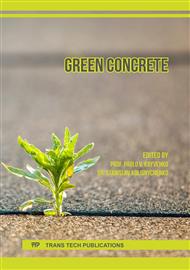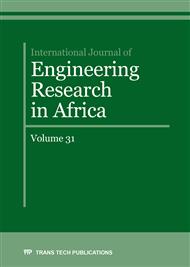[1]
Y. Aggarwal, R. Siddique. Microstructure and properties of concrete using bottom ash and waste foundry sand as partial replacement of fine aggregates. Construction and Building Materials 54 (2014) 210–223.
DOI: 10.1016/j.conbuildmat.2013.12.051
Google Scholar
[2]
Information on http: /www2. epa. gov/recycle.
Google Scholar
[3]
C.J. Kibert. Establishing principles and a model for sustainable construction. In: Proceedings of the First International Conference of CIB Task Group 16 on Sustainable Construction, Tampa, FL, 6–9 November, 1994, p.3–12.
Google Scholar
[4]
R.C. Hill, P. Bowen. Sustainable construction: principles and a framework for attainment. Constr. Manage. Econ. 15 (1997) 223–239.
Google Scholar
[5]
K.L. Scrivener, R.J. Kirkpatrick. Innovation in use and research on cementitious material, Cem. Concr. Res. 38 (2008) 128–136.
Google Scholar
[6]
J.L. Provis, J.S. van Deventer (eds), Alkali Activated Materials: state-of-the-art report, RILEM TC 224 -AAM, RILEM state-of-the-art reports 13, Springer, (2014).
DOI: 10.1007/978-94-007-7672-2
Google Scholar
[7]
K.P. Mehta, P.J.M. Monteiro. Concrete: microstructure, properties, and materials, fourth ed., New York, McGraw-Hill, (2006).
Google Scholar
[8]
C. Meyer. The greening of the concrete industry. Cem. Concr. Compos. 31(2009) 601–605.
Google Scholar
[9]
A. Bilodeau, V.M. Malhotra. High volume fly ash system: concrete solution for sustainable development. ACI Materials Journal. 1 (2000) 41-47.
DOI: 10.14359/804
Google Scholar
[10]
W.H. Chesner, R.J. Coollins, M.H. Mackay. User guidelines for waste and byproduct materials in pavement construction. US Department of transportation, federal highway administration, Publication No. FHWA-RD; 1997, p.97–148.
Google Scholar
[11]
Ling Tung-Chai, Poon Chi-Sun, Wong Hau-Wing. Management and recycling of waste glass in concrete products: current situations in Hong Kong. Resour Conserv Recycl. 70 (2013) 25–31.
DOI: 10.1016/j.resconrec.2012.10.006
Google Scholar
[12]
R. Siddique, Waste glass, in: R. Siddique, Waste materials and by-products in concrete, Springer, Berlin, 2008, p.147–175.
DOI: 10.1007/978-3-540-74294-4_5
Google Scholar
[13]
A.M. Rashad, Recycled waste glass as fine aggregate replacement in cementitious materials based on Portland cement. Construction and Building Materials. 72 (2014) 340–357.
DOI: 10.1016/j.conbuildmat.2014.08.092
Google Scholar
[14]
Y. Jani, W. Hogland. Waste glass in the production of cement and concrete. Journal of environmental chemical engineering. 2 (2014) 1767-1775.
DOI: 10.1016/j.jece.2014.03.016
Google Scholar
[15]
K. Afshinnia, P. R. Rangaraju. Impact of combined use of ground glass powder and crushed glass aggregate on selected properties of Portland cement concrete. Con. Bui. Mat. 117 (2016) 263–272.
DOI: 10.1016/j.conbuildmat.2016.04.072
Google Scholar
[16]
IEA. Tracking industrial energy efficiency and CO2 emissions. OECD/IEA; 2007, p.1–321.
Google Scholar
[17]
A. Schmitz, J. Kaminski, Scalet B. Maria, A. Soria. Energy consumption and CO2 emissions of the European glass industry, Energy Policy 39 (2011) 142–155.
DOI: 10.1016/j.enpol.2010.09.022
Google Scholar
[18]
European Commission, Environmental Statistics and Accounts in Europe, Eurostat Statistical Books, (2010).
Google Scholar
[19]
EPA. Municipal solid waste generation, recycling, and disposal in the United States: facts and figures for 2010. United States Environmental Protection Agency, EPA-530-F-005; December 2011. p.1–12.
DOI: 10.7551/mitpress/8829.003.0010
Google Scholar
[20]
Information on http: /www. epa. gov/epawaste/conserve/materials/glass. htm (2014).
Google Scholar
[21]
Ramboll Okopol. Study on recyclable waste glass in the context of the development of end-of-waste criteria for the EU waste framework directive. Interim report; (2010).
Google Scholar
[22]
C.D. Johnston, Waste glass as coarse aggregate for concrete, Journal of Testing and Evaluation 2 (1974) 344–350.
Google Scholar
[23]
R.G. Pike, D. Hubbard. Physicochemical studies of the destructive alkali aggregate reaction in concrete, Journal of Research of the National Bureau of Standards. 59 (1957) 127–132.
DOI: 10.6028/jres.059.013
Google Scholar
[24]
O.M. Olofinnade, A.N. Ede, J.M. Ndambuki. Sustainable green environment through utilization of waste soda-lime glass for production of concrete. Jour. of Mat. Env. Sci. 8(2017) 1139-1152.
Google Scholar
[25]
Z.Z. Ismail, E.A. Al-Hashmi. Recycling of waste glass as a partial replacement for fine aggregate in concrete. Waste Manag. 29 (2009) 655-659.
DOI: 10.1016/j.wasman.2008.08.012
Google Scholar
[26]
K.H. Tan, H. Du. Use of waste glass as sand in mortar. Part I. Fresh, mechanical and durability properties. Cem. Concr. Compos. 35 (2013) 109–117.
DOI: 10.1016/j.cemconcomp.2012.08.028
Google Scholar
[27]
W.K. Kupolati, W.T. Mbadie, J.M. Ndambuki, R. Sadiku. Environmental greening through utilization of glass waste for production of concrete, OIDA Int. J. Sus. Dev. 6 (2014) 37-50.
Google Scholar
[28]
M. Carsana, M. Frassoni, L. Bertolini. Comparison of ground waste glass with other supplementary cementitious materials, Cement Concr. Compos. 45 (2014) 39–45.
DOI: 10.1016/j.cemconcomp.2013.09.005
Google Scholar
[29]
K. Afshinnia, P.R. Rangaraju. Influence of fineness of ground recycled glass on mitigation of alkali–silica reaction in mortars, Constr. Build. Mater. 81 (2015) 257–267.
DOI: 10.1016/j.conbuildmat.2015.02.041
Google Scholar
[30]
O.M. Olofinnade, J.M. Ndambuki, A.N. Ede, D.O. Olukanni, Effect of substitution of crushed waste glass as partial replacement for natural fine and coarse aggregate in concrete. Mater Sci. Forum 866 (2016) 58-62.
DOI: 10.4028/www.scientific.net/msf.866.58
Google Scholar
[31]
K. Afshinnia, P. Rangaraju. Effectiveness of ground glass powder from recycled glass in mitigating alkali-silica reaction in concrete, J. Trans. Res. Board 2508 (2015) 10.
DOI: 10.3141/2508-08
Google Scholar
[32]
V. Corinaldesi, G. Gnappi, G. Moriconi, A. Montenero. Reuse of ground waste glass as aggregate for mortars. Waste Management 25 (2005) 197–201.
DOI: 10.1016/j.wasman.2004.12.009
Google Scholar
[33]
R. Idir, M. Cyr, A. Tagnit-Hamou. Use of fine glass as ASR inhibitor in glass aggregate mortars, Construction and Building Materials 24 (2010) 1309–1312.
DOI: 10.1016/j.conbuildmat.2009.12.030
Google Scholar
[34]
S. de Castro, J. de Brito. Evaluation of the durability of concrete made with crushed glass aggregates, Journal of Cleaner Production 41 (2013) 7–14.
DOI: 10.1016/j.jclepro.2012.09.021
Google Scholar
[35]
S.B. Park, B.C. Lee, J.H. Kim. Studies on mechanical properties of concrete containing waste glass aggregate, Cement and Concrete Research 34 (2004) 2181–2189.
DOI: 10.1016/j.cemconres.2004.02.006
Google Scholar
[36]
I.M. Metwally. Investigations on the performance of concrete made with blended finely milled waste glass. Adv. Struct Eng. 10 (2007) 47–53.
DOI: 10.1260/136943307780150823
Google Scholar
[37]
M. Batayneh. I. Marie, I. Asi. Use of selected waste materials in concrete mixes, Waste Management. 27 (2007) 1870–1876.
DOI: 10.1016/j.wasman.2006.07.026
Google Scholar
[38]
M. Mageswari, B. Vidivelli. The use of sheet glass powder as fine aggregate replacement in concrete, Open Civil Engineering Journal 4 (2010) 65–71.
DOI: 10.2174/18741495010040100065
Google Scholar
[39]
IB. Topçu, M. Canbaz. Properties of concrete containing waste glass, Cement and Concrete Research 34 (2004) 267–274.
DOI: 10.1016/j.cemconres.2003.07.003
Google Scholar
[40]
S.C. Kou, C.S. Poon. Properties of self-compacting concrete prepared with recycled glass aggregate, Cement Concr. Compos. 31 (2009) 107–113.
DOI: 10.1016/j.cemconcomp.2008.12.002
Google Scholar
[41]
Ö. Özkan, I. Yüksel. Studies on mortars containing waste bottle glass and industrial by-products, Constr. Build. Mater. 22 (2008) 1288–1298.
DOI: 10.1016/j.conbuildmat.2007.01.015
Google Scholar
[42]
N. Schwarz, N. Neithalath. Influence of a fine glass powder on cement hydration: comparison to fly ash and modeling the degree of hydration, Cem Concr Res 38 (2008) 429–436.
DOI: 10.1016/j.cemconres.2007.12.001
Google Scholar
[43]
R. Takata, S. Sato, T. Nonaka, H. Ogata, K. Hattori. Investigation on alkali–silica reaction utilizing waste glass in concrete and suppression effect by natural zeolite. 29th Conference on Our World in Concrete and Structures, 25-26 August, Singapore, (2004).
Google Scholar
[44]
M.J. Terro. Properties of concrete made with recycled crushed glass at elevated temperatures. Building and Environment, 41 (2006) 633–639.
DOI: 10.1016/j.buildenv.2005.02.018
Google Scholar
[45]
Y. Shao, T. Lefort, S. Moras. D. Rodriguez, Studies on concrete containing ground waste glass, Cem. Concr. Res. 30 (2000) 91–100.
DOI: 10.1016/s0008-8846(99)00213-6
Google Scholar
[46]
B. Taha, G. Nounu. Properties of concrete contain mixed colour waste recycled glass as sand and cement replacement. Construction & Building Materials, 22 (2008) 713–720.
DOI: 10.1016/j.conbuildmat.2007.01.019
Google Scholar
[47]
A. Shayan, A. Xu. Performance of glass powder as a pozzolanic material in concrete: a field trial on concrete slabs, Cement and Concrete Research 36 (2006) 457–468.
DOI: 10.1016/j.cemconres.2005.12.012
Google Scholar
[48]
A.M. Matos, J. Sousa-Coutinho, Durability of mortar using waste glass powder as cement replacement, Construction and Building Materials 36 (2012) 205–215.
DOI: 10.1016/j.conbuildmat.2012.04.027
Google Scholar
[49]
A. Khmiri, B. Samet, M. Chaabouni. A cross mixture design to optimise the formulation of a ground waste glass blended cement, Construction and Building Materials 28 (2012) 680–686.
DOI: 10.1016/j.conbuildmat.2011.10.032
Google Scholar
[50]
BS EN 197-2000 Cement, Composition, specifications, and conformity criteria for common cements.
Google Scholar
[51]
ASTM C618. Standard Specification for Coal Fly Ash and Raw or Calcined Natural Pozzolan for Use in Concrete. American society for testing and materials. West Conshohocken, PA: ASTM International; (2003).
DOI: 10.1520/c0618-15
Google Scholar
[52]
BS EN 12350-2. Testing of Fresh concrete; part 2: slump test. European Committee for Standardization; (2009).
Google Scholar
[53]
BS EN 12390-3. Testing hardened concrete; part 3: compressive strength of test specimens. European Committee for Standardization; (2002).
Google Scholar
[54]
BS EN 12390-6. Testing hardened concrete; part 6: split tensile strength of test specimens. European Committee for Standardization; (2002).
Google Scholar



